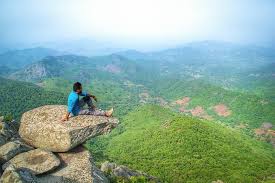

| Index |
| S.No | Topic |
|
| Daily Hindu Analysis |
| 1. | Eight States with international borders, 0.13% of exports |
|
| 2. | Cooling rights in a sweltering South |
|
| 3. | Delhi govt., IIT Kanpur sign MoU for artificial rain trials |
|
| 4. | 50% of U.P. industries flout norms: report on Ganga pollution |
|
| 5. | Defence Ministry, HAL ink ₹62,370-cr. deal for 97 light combat aircraft for IAF |
|
| 6. | DRDO conducts rail based launch of Agni-Prime missile |
|
|
| 7. | Sahyog Portal |
|
| 8. | Central Board of Film Certification (CBFC) |
|
| 9. | UNEP Young Champions of the Earth Award 2025 |
|
| 10. | The Viksit Bharat Buildathon 2025 |
|
| 11. | Mahendragiri Hills |
|
| 12. | India Elected as Member of Interpol Asian Committee |
|
| 13. | Tamil Nadu Coastal Restoration Mission (TN-SHORE) |
|
Eight States with international borders,0.13% of exports 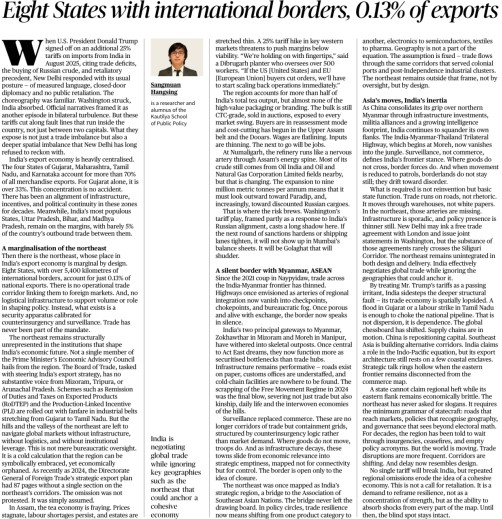
Syllabus Mapping
GS Paper 3 (Indian Economy - Issues relating to planning, mobilization of resources, growth, development, and employment; Inclusive growth and issues arising from it) GS Paper 2 (Governance - Important aspects of governance, transparency, and accountability; International Relations - India and its neighborhood – relations)
Context ·
In August 2025, the U.S. under Donald Trump imposed an additional 25% tariff on Indian imports, citing trade deficits, India’s purchase of Russian crude oil despite sanctions, and past precedents like steel tariffs. · The move, announced amid U.S.-China tensions, exposed vulnerabilities in India’s export-dependent economy, heavily reliant on the U.S. for textiles, pharmaceuticals, and electronics. · India’s response was measured diplomacy without public retaliation, but it revealed structural flaws in the country’s trade setup. · Exports are spatially concentrated in coastal hubs, so disruptions there create nationwide ripple effects. · In contrast, the northeastern states, despite sharing 5,400 km of international borders with five countries (longer than the western frontier), contribute only 0.13% of exports, lacking operational trade corridors. · This neglect keeps the northeast as an economic enclave under a “silent border” approach, worsening tariff shocks and weakening India’s Act East Policy, hence the call for inclusive border trade. Detailed Analysis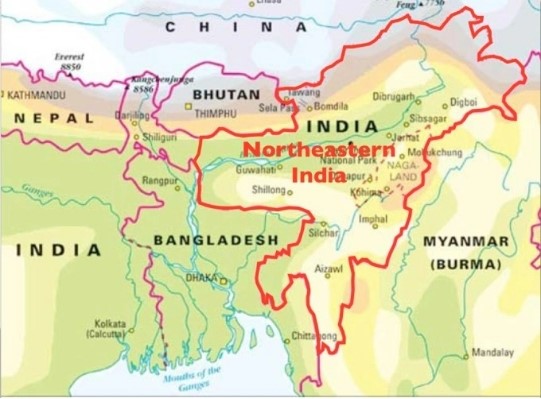
- Rationale and Immediate Triggers: Trump justified the 25% hike as a pushback against India's "unfair" practices, referencing a $30 billion-plus trade surplus, discounted Russian oil imports (e.g., via the Chennai-Vladivostok corridor), and past U.S. vulnerabilities like the 2018 steel tariffs.
- He quipped that India's response—offering to scale back operations by half—mirrors oversupply in European markets, demanding reciprocity in sectors like agriculture and manufacturing.
- India's Diplomatic Restraint: Unlike knee-jerk retaliations, India opted for quiet negotiations, absorbing the blow without escalating. This reflects a maturing IR posture but masks domestic frailties: tariffs could shave 0.5-1% off GDP growth, per early estimates, hitting export-led states hardest.
Spatial Imbalance in India's Export Economy - Centralized Hubs Dominate: Over 70% of exports emanate from Gujarat, Tamil Nadu, and Maharashtra—non-border states with robust infrastructure (e.g., Gujarat's ports handle 40% of oil imports). This concentration is "no accident," rooted in policy favoring coastal logistics over inland frontiers, leaving the northeast's 5.5% population share translating to negligible trade volumes.
- Security vs. Commerce Trade-Off: Border zones like Arunachal Pradesh (China frontier) and Tripura (Bangladesh adjacency) see investments skewed toward surveillance—fencing, patrols, and intelligence—rather than connectivity. Result: 95% of outbound trade between these states remains internal, with no cross-border corridors operational despite 31% of India's land borders here.
The Neglected Northeast: Borders Without Economic Lifelines - Geographic and Resource Riches Untapped: These eight states boast diverse assets—Assam's crude oil (ONGC fields), Nagaland's minerals, Manipur's horticulture—but poor logistics choke exports. High-value goods like organic teas or bamboo crafts rot due to absent cold chains, while natural gas from Tripura's fields lacks pipelines to global markets.
- Quantitative Disparities: At 0.13% export share, the region lags even landlocked neighbors like Bhutan (via integrated check posts). The "design flaw": industrial clusters are oversight-driven, not opportunity-led, with no SEZs or export processing zones despite proximity to ASEAN's $3 trillion market.
Case Study: The Silent Border with Myanmar – A Missed ASEAN Gateway - Proximity Without Integration: The India-Myanmar border, spanning 1,643 km, is a "silent frontier" post-2021 coup, with trade halved to $1.2 billion.
- Mizoram and Manipur host limited outlets (e.g., Zokhawthar in Mizoram), but inadequate gateways—roads, rails, cold storage—stifle perishables like Manipur's pineapples or Nagaland's kiwi.
- ASEAN Linkage Gaps: Unlike China's grip on northern Myanmar alliances, India's influence wanes. The article laments underexploited potentials: Moreh (Manipur) as a trade hub for Thai electronics or Indonesian palm oil, yet insurgency logic fragments development, eroding local trust and perpetuating underdevelopment.
- Infrastructure Bottlenecks: Cold-chain facilities are "nowhere to be found," with final-mile logistics absent. This contrasts with western borders' vibrancy (e.g., Attari-Wagah with Pakistan), where truck traffic sustains $2 billion trade despite tensions.
Broader Implications: From Economic Exclusion to Geopolitical Blind Spots - Lost Regional Synergies: The northeast's marginalization fragments India's supply chains, amplifying tariff risks. Without diversification, sectors like textiles (textile parks in Tripura) or pharma (generic hubs in Assam) remain nascent.
- Environmental spillovers—like deforestation from unchecked logging—exacerbate climate vulnerabilities, while governance silos (central vs. state) hinder holistic planning.
- Path Forward: A "strategic embrace" via trade-centric plans (e.g., 35 new directorate initiatives) could unlock $10-15 billion in annual exports, fostering inclusivity and countering China's Belt and Road inroads.
UPSC Value Addition Urban-Rural Linkages, Regional Disparities - Spatial Economics and Border Geography: The northeast's 5,400 km frontiers highlight "peripheral development," akin to NITI Aayog's Aspirational Districts. Link to Act East Policy (2014)—envisioned as a bridge to ASEAN but stalled by infrastructure gaps; e.g., the India-Myanmar-Thailand Trilateral Highway (IMTTH, 1,360 km) remains 70% complete, delayed by Myanmar's instability, limiting Manipur-Mae Sot connectivity.
- Socio-Environmental Dimensions: Underexploited resources (Assam's 20% of India's tea output) fuel migration and insurgency; value add: Free Movement Regime (FMR) with Myanmar allows 16 km visa-free crossings but is underutilized due to security curbs, exacerbating demographic pressures (e.g., 30% youth unemployment in Nagaland).
Federalism, Border Diplomacy - Federal Tensions and Nativism: Centralized export policy sidelines states like Mizoram (ASEAN adjacency), echoing 15th Finance Commission recommendations for border grants (₹48,000 crore for 111 districts). RODTEP (Remission of Duties and Taxes on Exported Products, 2021)—a WTO-compliant successor to MEIS—offers 0.5-4% rebates but underperforms in the northeast (only 2% claims from region), due to compliance hurdles for SMEs.
- IR Angle: Trump's tariffs underscore "weaponized trade" in US-India iCET (Initiative on Critical and Emerging Technology); counter with "Act East" revival—e.g., BIMSTEC (Bay of Bengal Initiative) for Myanmar gateways. Free Movement Regimes (FMRs) with Bhutan/Nepal succeed (₹10,000 crore trade), but Myanmar's version needs revival post-coup to preempt China's Gwadar-like inroads.
- Export Diversification Imperative: Amid PLIs (Production Linked Incentives, ₹1.97 lakh crore across 14 sectors), northeast lags—e.g., no electronics PLI uptake in Assam despite semiconductor potential. Value add: RODTEP's integration with PLIs could boost organics (Mizoram's 20% GI-tagged products) to $5 billion exports, aligning with Atmanirbhar Bharat's supply chain resilience.
- Security-Development Nexus: Border neglect fuels "development deficit terrorism" (e.g., NSCN in Nagaland); link IMTTH to NEC (North Eastern Council) visions for rail (e.g., Jiribam-Imphal line) and cold chains, reducing import dependence (northeast's 60% food imports). Holistic fix: Border Infrastructure and Management (BIM) scheme (₹13,000 crore) for 50 ICPs, but execution gaps persist—target 20% export rise via ASEAN FTAs.
UPSC Mains Northeastern states share long international borders but contribute very little to India’s exports. What are the main reasons for this? How can the Act East Policy help improve trade from the region?

2. Cooling rights in a sweltering South
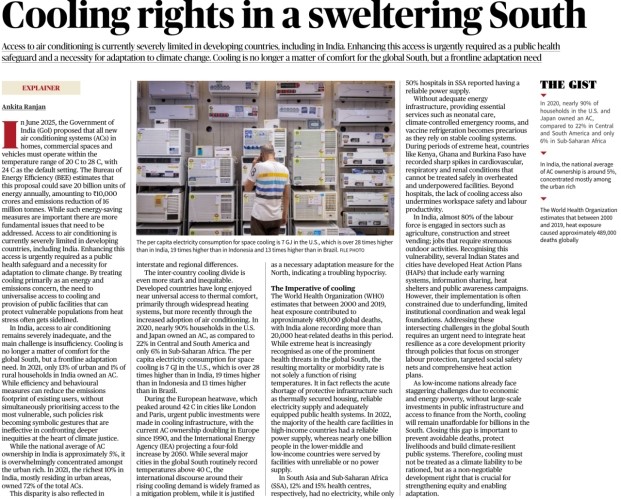
Syllabus Mapping
GS Paper 3 (Environment - Conservation, environmental pollution and degradation, environmental impact assessment; Science and Technology - Developments and their applications and effects in everyday life) GS Paper 2 (Governance - Issues relating to development and management of Social Sector/Services relating to Health; International Relations - Important International institutions, agencies and fora - their structure, mandate)
Context:
Amid escalating global temperatures driven by climate change, access to cooling technologies like air conditioning (AC) has transitioned from a luxury to a public health imperative, particularly in the Global South where heatwaves are intensifying. · Triggered by India's June 2025 government proposal for mandatory energy-efficient AC systems in new homes, commercial spaces, and vehicles, the piece underscores the urgency of cooling as an adaptation strategy. · Globally, the World Health Organization (WHO) estimates that between 2000 and 2019, approximately 489,000 heat-related deaths occurred annually, with projections of a 370% surge by 2050 if unchecked. · In India, where summer temperatures routinely exceed 40°C and the national average AC ownership is around 5% (concentrated among the urban rich), this disparity exacerbates health risks, productivity losses, and socio-economic inequalities. · The context is amplified by regional comparisons: while the U.S. boasts 90% AC ownership, Sub-Saharan Africa lingers at 6%, and India at 5%—revealing a "cooling divide" that mirrors broader North-South inequities in climate resilience.
Detailed Analysis The Imperative of Cooling: From Comfort to Survival
- Health and Vulnerability Risks: The WHO's data (2000-2019) attributes 489,000 annual global deaths to heat exposure, with a projected rise to over 1 million by 2050.
- In India, heatwaves cause untreated conditions like cardiovascular strain, renal issues, and underpowered facilities in hospitals, leading to overwhelmed healthcare systems.
- Vulnerable groups—infants, elderly, outdoor workers (e.g., in agriculture, construction)—face amplified risks, with productivity dips of 20-30% in labor-intensive sectors.
- Global Disparities in AC Ownership: AC penetration is starkly uneven: 90% in the U.S. and Japan, 22% in Central and South America, but only 6% in Sub-Saharan Africa and 5% in India (mostly among the urban rich).
- This "cooling gap" is widest in the hottest regions, where per capita electricity for cooling in India is 19 times lower than in Indonesia and 13 times lower than in Brazil.
- Economic and Productivity Impacts: Heat stress reduces workforce efficiency, with the International Labour Organization (ILO) estimating 489,000 heat-related deaths globally and significant losses in outdoor activities.
- In India, sectors like agriculture (80% of labor force engaged) and street vending suffer, necessitating stronger social safety nets.
Regional Cooling Differentials and Challenges - Inter-Country Variations: Developed nations like the U.S. (over 28 times higher per capita cooling electricity than India) and Japan (owned by 90% of households) have universal access, while the Global South lags.
- In Europe, recent heatwaves (e.g., 2022) doubled AC ownership in some areas, but adoption remains below 20%. Brazil and Indonesia show higher urban penetration due to policy pushes, contrasting India's 5% average.
- Intra-Country Inequities in India: Ownership is concentrated in urban areas (24°C default setting for energy efficiency), with rural households largely excluded.
- Energy and Environmental Trade-Offs: Increased AC adoption could strain grids (e.g., India's BEE star-rated systems aim to save 20 billion units annually), but without efficiency measures, it risks higher emissions.
Policy Responses and the Path Forward - India's Initiatives: The 2025 GoI proposal mandates ACs in new builds, aligning with the India Cooling Action Plan (ICAP, 2019), which targets a 25-40% reduction in cooling energy demand by 2037-38 through star ratings and refrigerant transitions. However, affordability remains a barrier, with ACs inaccessible to low-income groups.
- Global Frameworks: The WHO advocates for cooling in healthcare and public spaces, while the article urges policies like subsidies for low-income nations, heat action plans (HAPs), and legal foundations for addressing challenges. It stresses integrating cooling into NDCs (Nationally Determined Contributions) under the Paris Agreement.
UPSC Value Addition Alignment with SDGs: It connects to India's commitments under Sustainable Development Goals (SDGs), specifically SDG 13 (Climate Action) for climate resilience and SDG 3 (Health) for addressing heat-related public health challenges.
National Action Plan on Climate Change (NAPCC, 2008): The topic aligns with NAPCC's framework, which emphasizes climate adaptation and mitigation strategies, including cooling as a public health measure.
Energy Conservation Act (Amended 2022): It supports the amended Act's promotion of the Bureau of Energy Efficiency (BEE) star labeling for ACs, aimed at enhancing energy efficiency and reducing environmental impact.
India Cooling Action Plan (ICAP, 2019): Incorporates ICAP's objectives for sustainable cooling, including the phase-down of hydrofluorocarbons (HFCs) under the Kigali Amendment to the Montreal Protocol, targeting a 20-30% reduction in cooling-related emissions by 2030.
Economic Survey 2024-25 Insights: Highlights urban-rural divides, noting heatwaves cost approximately 1.5% of India's GDP annually, underscoring the economic stakes of cooling access.
Pradhan Mantri Awas Yojana (PMAY): Relevant for integrating energy-efficient housing with cooling solutions to address heat vulnerabilities in rural and urban poor communities.
Ayushman Bharat: Ties to enhancing healthcare infrastructure resilience against heatwaves, ensuring access to cooling in medical facilities for vulnerable populations.
COP28 Global Cooling Pledge (2023): Reflects India's commitment to achieving net-zero cooling by 2050, a global benchmark for climate adaptation strategies.
ILO Data (2023 Report): Provides evidence with 2.4 billion workers at heat risk globally, enabling data-driven arguments for equitable cooling policies in answers.
UNFCCC Negotiations: Emphasizes the need for equity in climate finance and technology transfer for the Global South, positioning cooling as a negotiation priority at international climate forums.
UPSC Mains
Cooling is no longer a matter of comfort for the Global South but a frontline adaptation need.” In the context of rising temperatures and climate change, critically examine the challenges of ensuring universal access to cooling in India. Suggest measures to balance public health needs with energy and environmental concerns.
3.Delhi govt., IIT Kanpur sign MoU for artificial rain trials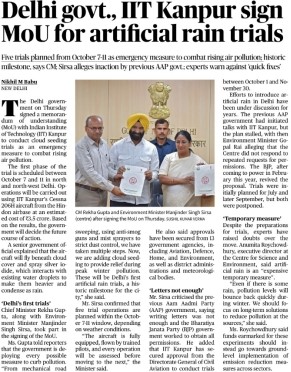
GS Paper 3 (Environment - Conservation, environmental pollution and degradation, environmental impact assessment; Science and Technology - Developments and their applications and effects in everyday life) GS Paper 2 (Governance - Issues relating to development and management of Social Sector/Services relating to Health, Education, Human Resources; Government policies and interventions for development in various sectors and issues arising out of their design and implementation)
Context:
The Delhi government, in partnership with IIT-Kanpur and the Department of Environment, is launching its first cloud seeding (artificial rain) pilot project to combat severe winter air pollution. · Trial Schedule and Logistics: Five operations are planned within the October 7-11 window, weather-dependent, with fully equipped aircraft flown by trained pilots. Each trial will be assessed before proceeding, marking Delhi's first such initiative. · Cost and Future Decisions: Estimated at ₹3.5 crore, the government will evaluate results to decide on scaling up, integrating it with ongoing measures like mechanical road sweeping, anti-smog guns, mist sprayers, and strict dust control.
What is Artificial Rain (cloud seeding)? Cloud Seeding
About: It is a weather modification technique that aims at enhancing precipitation (generate artificial rain) from clouds. · Method: Uses chemicals like silver iodide, potassium iodide, and dry ice, which are dispersed into the sky via airplanes and helicopters. · These chemicals attract water vapour (acting as nuclei), helping form rain clouds.
Types: Hygroscopic Cloud Seeding (accelerates the merging of droplets in liquid clouds) and Glaciogenic Cloud Seeding (induces ice formation in super cooled clouds).
Cloud Seeding as a solution to Climate Change: Arguments in Favor · Regulates prevailing Weather Conditions: Regulates water vapour preventing damage by hails and storms; causes more winter snowfall, etc. · Enhances Natural Water Supply: Making drier areas more liveable and supporting local communities. · Disperses Air Pollutants: Reduces the concentration of dust, smoke, smog, etc., helps control wildfires. · Benefits Agriculture: Provides moisture to crops.
Arguments Against · Lack of Research: Lack of sufficient data to prove its effectiveness as a solution to pollution like the one witnessed in Delhi. · Suitability: Requires presence of moisture-filled clouds as not all clouds are suitable for seeding. · Impact of chemicals used: Silver Iodide (most preferred material) may cause iodism (type of iodine poisoning) proving toxic to terrestrial and aquatic life. · Economic Viability: May cost around ₹1 lakh per square kilometer.
UPSC Prelims
Artificial way of causing rainfall to reduce air pollution makes use of
(a) silver iodide and potassium iodide
(b) silver nitrate and potassium iodide
(c) silver iodide and potassium nitrate
(d) silver nitrate and potassium chloride
Answer: a
4. 50% of U.P. industries flout norms: report on Ganga pollution
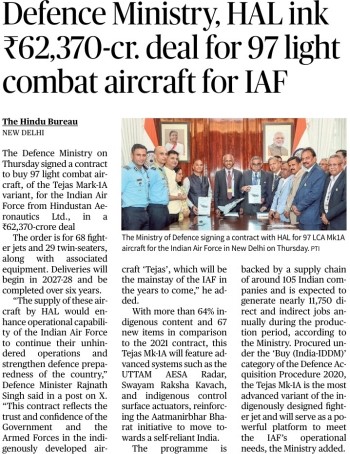
GS Paper 3 (Environment - Conservation, environmental pollution and degradation, environmental impact assessment; Disaster Management - Vulnerability profile of India): GS Paper 2 (Governance - Important aspects of governance, transparency, and accountability; Government policies and interventions for development in various sectors and issues arising out of their design and implementation)
Context
- The Central Pollution Control Board (CPCB) submitted a report to the National Green Tribunal (NGT) on the state of industrial compliance with pollution norms in Uttar Pradesh.
- The report reveals that over 50% of Grossly Polluting Industries (GPIs) in the state are not following mandated environmental regulations.
- This comes in the backdrop of the Allahabad High Court (July 2022) directive asking CPCB to collect and test samples from industries contributing to Ganga pollution.
- The inspections covered 1,370 GPIs across UP (858 operational, 512 non-operational).
- Findings:
- 443 of 858 operational units were non-compliant.
- Among non-operational units, 36 sewage treatment plants (STPs) and 8 effluent treatment plants (ETPs) were inspected; some were found operational despite being listed as “non-operational”.
Analysis 1. Environmental Governance Concerns · The fact that over half of operational GPIs flout pollution norms points to weak enforcement of laws like the Water (Prevention and Control of Pollution) Act, 1974 and the Environment Protection Act, 1986. · It exposes the regulatory gaps in monitoring and the lack of strict penalties for defaulters.
2. Impact on Ganga Rejuvenation Efforts · Industrial effluents, especially from tanneries, sugar mills, and distilleries in UP, are a major contributor to Ganga pollution. · Despite large-scale initiatives like the Namami Gange Programme, pollution levels remain high because of non-compliance by industries. · Failure of STPs and ETPs worsens the situation by letting untreated sewage and waste flow directly into the river.
3. Judicial Oversight · The Allahabad High Court and the NGT play a crucial role in compelling regulatory agencies like CPCB to act. · However, judicial activism cannot substitute for sustained administrative vigilance.
4. Economic vs. Environmental Trade-off · UP is an industrial hub, and industries often cite high operational costs of effluent treatment as a reason for bypassing norms. · But such non-compliance creates long-term ecological and health costs, outweighing short-term economic savings.
5. Systemic Issues · Inspection gaps: Inspections are often one-time or superficial. · Data manipulation: Units may show compliance during checks but pollute otherwise. · Institutional weakness: State Pollution Control Boards often lack manpower, equipment, and political will.
UPSC Prelims
Q. Which of the following bodies is responsible for monitoring Grossly Polluting Industries (GPIs) in India?
A. National Green Tribunal (NGT)
B. Central Pollution Control Board (CPCB)
C. Ministry of Jal Shakti D. State Pollution Control Boards (SPCBs)
Answer: B.
5. Defence Ministry, HAL ink ₹62,370-cr. deal for 97 light combat aircraft for IAF 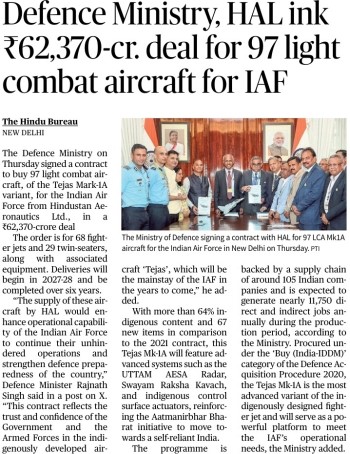
Syllabus: GS Paper 3 (Technology - Indigenization of technology and developing new technology; Defence - Various Security forces and agencies and their mandate; Internal Security - Linkages between development and spread of extremism) GS Paper 2 (International Relations - Bilateral, regional and global groupings and agreements involving India and/or affecting India’s interests)
Context
- The Defence Ministry signed a ₹62,370 crore contract with Hindustan Aeronautics Limited (HAL) for 97 Tejas Mk-1A Light Combat Aircraft (LCA) for the Indian Air Force (IAF).
- The order includes 68 fighter jets and 29 twin-seaters, with deliveries starting in 2027-28 and completing in six years.
- This move reflects the government’s emphasis on Atmanirbhar Bharat (self-reliance in defence production) and boosting indigenous defence capability.
- The deal is under the ‘Buy (India-IDDM)’ category of the Defence Acquisition Procedure (2020), which promotes Indigenously Designed, Developed and Manufactured products.
Analysis 1. Strategic Significance o Strengthens IAF’s depleted fighter squadron strength (currently below sanctioned levels of 42 squadrons). o Enhances operational readiness for diverse theatres (Pakistan, China). o Boosts defence preparedness by replacing ageing MiG-21s.
2. Indigenisation Push o Over 64% indigenous content; backed by 105 Indian companies in the supply chain. o Generates nearly 11,750 direct and indirect jobs, strengthening defence-industrial ecosystem. o Aligns with Aatmanirbhar Bharat and reduces import dependence on foreign jets.
3. Technological Edge o Incorporates 67 new systems compared to earlier Tejas variants. o Features advanced UTTAM AESA Radar, Swayam Raksha Kavach (self-protection suite), and indigenous control surface actuators. o Designed to be a versatile multi-role aircraft for both offensive and defensive operations.
4. Economic & Industrial Impact o Strengthens HAL’s production pipeline, showcasing India’s ability to mass-produce indigenous jets. o Positions India as a potential exporter of combat aircraft in the global market (talks ongoing with Malaysia, Egypt, Argentina).
Key Features of Tejas Light Combat Aircraft (Mk-1A variant)
- Category: 4.5 Generation, supersonic, multi-role fighter jet.
- Indigenous Content: 64%+, increasing with upgrades.
- Weapons: Air-to-air, air-to-surface, precision-guided munitions.
- Radar: UTTAM AESA Radar (indigenous, advanced).
- Protection: Electronic warfare suite, self-protection systems.
- Design: Lightweight, highly maneuverable, suited for both offensive strikes and defensive interception.
- Range: Around 1,850 km (ferry range).
- Speed: Mach 1.6 (pprox.).
International Comparisons (Similar Light Combat Aircrafts Worldwide) Several nations operate in the light/multi-role fighter category, balancing cost-effectiveness with capability: 1. JF-17 Thunder (Pakistan-China) To be Jointly developed by Pakistan Aeronautical Complex (PAC) and China’s Chengdu Aircraft. o Cheaper alternative to Western jets; widely exported (Nigeria, Myanmar).
2. KAI FA-50 (South Korea) Light combat aircraft derived from T-50 trainer. o Exported to Philippines, Poland, Iraq.
3. JAS-39 Gripen (Sweden) o Saab’s lightweight, versatile multi-role fighter. o More advanced but significantly costlier than Tejas.
4. M-346FA (Italy) o Primarily an advanced trainer, but adapted as a light attack/air defence fighter.
UPSC Prelims Q. With reference to India’s Light Combat Aircraft (LCA) Tejas Mk-1A, consider the following statements:
1. It is being manufactured by Hindustan Aeronautics Limited (HAL).
2. It is equipped with an indigenous Active Electronically Scanned Array (AESA) radar called UTTAM.
3. It has been procured by the Indian Air Force under the ‘Buy (India-IDDM)’ category of the Defence Acquisition Procedure. Which of the statements given above is/are correct? A. 1 and 2 only
B. 2 and 3 only
C. 1 and 3 only
D. 1, 2 and 3
Answer: D. 1, 2 and 3
6. DRDO conducts rail based launch of Agni-Prime missile Syllabus: GS Paper 3 (Security, Science & Technology)
- Science & Technology
- Indigenisation of technology and developing new technology.
- Developments and applications of science and technology in defence.
- Internal Security
- Role of science and technology in internal security.
- Defence preparedness and modernization of armed forces.
GS Paper 2 International Relations) - Effect of policies and politics of developed and developing countries on India’s interests.
- Bilateral, regional and global groupings and their security implications.
Context - The Defence Research and Development Organisation (DRDO) and the Strategic Forces Command (SFC) successfully conducted the first-ever rail-based launch of the Agni-Prime (Agni-P) Intermediate Range Ballistic Missile (IRBM).
- The missile was fired from a rail-based mobile launcher, under full operational conditions.
- Agni-Prime:
- Range: Up to 2,000 km.
- Features: Next-gen, incorporates advanced guidance and propulsion systems.
- Significance: Allows low-visibility, rapid deployment across the country, improving survivability and mobility.
- The trajectory was tracked by multiple ground stations, ensuring all mission objectives were achieved.
Analysis 1. Strategic Significance o Strengthens India’s nuclear deterrence capability under its “credible minimum deterrence” and No-First Use policy. o Rail mobility adds a layer of survivability: mobile launchers make detection and targeting by adversaries harder. o Complements road-based and canister-based launch systems, enhancing second-strike capability.
2. Technological Edge o Agni-P is a canisterised missile → easier storage, transport, and quick launch. o Rail mobility allows cross-country deployment with low visibility. o Incorporates advanced propulsion, composite materials, and guidance systems for higher accuracy.
3. Geopolitical Context o Timely amid increasing tensions with China and Pakistan, both of whom are expanding missile arsenals. o Demonstrates India’s growing indigenous missile capability, reducing dependence on imports.
Ballistic Missiles vs Cruise Missiles
| Feature | Ballistic Missiles | Cruise Missiles |
| Flight Path | Launched into high arc trajectory; follows ballistic path (like a projectile) | Flies at low altitudes, powered throughout, like an aircraft |
| Propulsion | Powered initially, then follows free-fall trajectory | Powered by jet/turbojet engine throughout |
| Speed | Usually faster (supersonic/hypersonic) | Typically slower (subsonic/supersonic) |
| Range | Generally longer (hundreds to thousands of km) | Usually shorter to medium (a few hundred to 2,500 km) |
| Guidance | Less maneuverable after initial boost phase | Highly maneuverable, can change path mid-flight |
| Detection | Easier to detect due to high arc | Harder to detect – low altitude & terrain-hugging flight |
| Examples (India) | Agni series, Prithvi series | BrahMos, Nirbhay |
| Primary Use | Strategic (nuclear deterrence, long-range strike) | Tactical/strategic (precision strikes, ships/ground targets) |
UPSC Prelims Q. With reference to the Agni-Prime missile recently test-fired by DRDO, consider the following statements:
1. It is an intermediate-range ballistic missile with a range of up to 2,000 km.
2. The recent test marked the first-ever launch of the missile from a rail-based mobile launcher.
3. It is equipped with advanced guidance systems and can be rapidly deployed with cross-country mobility.
Which of the statements given above is/are correct?
A. 1 and 2 only
B. 2 and 3 only
C. 1 and 3 only
D. 1, 2 and 3
Answer: D. 1, 2 and 3
7. Sahyog Portal
Syllabus: GS Paper II – Polity & Governance: Government Policies, IT Act and Regulation of Digital Platforms
Context: The Karnataka High Court recently upheld the Union Government’s Sahyog Portal, rejecting X Corporation’s challenge which termed it “extra-legal censorship.” Key Points
- Definition: An online regulatory platform for issuing takedown notices to internet intermediaries.
- Legal Basis: Operates under Section 79(3)(b) of the IT Act, 2000, ensuring removal of unlawful content.
- Ministry: Launched in October 2024 by the Union Home Ministry, managed via Indian Cyber Crime Coordination Centre (I4C).
- Aim: Streamline takedown communication, maintain safe harbour protections, and ensure prompt action against illegal content.
- Centralised Channel: Links 65 online intermediaries, state/UT nodal officers, and seven central agencies.
- Automated Notices: Enables faster, documented communication of takedown orders.
- Safe Harbour Implications: Non-compliance leads to loss of safe harbour immunity for intermediaries.
- Distinct from Section 69A: Unlike website blocking powers, it enforces responsibility of intermediaries to disable unlawful data.
- Public Good Tool: Strengthens cyber law enforcement and promotes a secure digital ecosystem.
8. Central Board of Film Certification (CBFC)
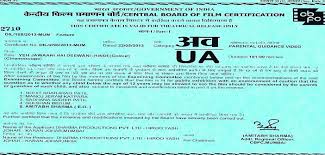
Syllabus: GS Paper II – Polity & Governance: Statutory and Regulatory Bodies Context: Recently, several films faced heavy censorship by the CBFC over caste, mythology, and political references, raising concerns over freedom of expression and certification practices.
Key Points
- Statutory Body: The CBFC is a statutory body under the Ministry of Information & Broadcasting.
- Certification Authority: Commonly called the Censor Board, but it primarily functions as a certification body.
- Legal Basis: Operates under the Cinematograph Act, 1952, Cinematograph (Certification) Rules, 1983, and Central Government Guidelines.
- Mandatory Certification: No film can be publicly released without CBFC certification.
- Structure: Headed by a Chairperson, with 12–25 members appointed by the Central Government.
- Regional Presence: Has nine regional offices – Mumbai, Kolkata, Chennai, Bangalore, Thiruvananthapuram, Hyderabad, New Delhi, Cuttack, and Guwahati.
- Advisory Panels: Panels nominated for two years assist in film examination.
- Certification Categories:
- U: Suitable for all ages.
- U/A: Parental guidance for children under 12.
- A: Restricted to adults only.
- S: Restricted to special classes (e.g., doctors, farmers).
- Recent Amendments (2023): New sub-categories introduced – UA 7+, UA 13+, UA 16+ – aligning with global best practices.
9. UNEP Young Champions of the Earth Award 2025
Syllabus: GS Paper III – Environment: Conservation, Environmental Pollution, and International Initiatives
Context: The United Nations Environment Programme (UNEP) announced the 2025 Young Champions of the Earth Award, recognising innovators from India, Kenya, and the US for their impactful environmental solutions.
Key Points
- Flagship Award: UNEP’s youth engagement award recognising entrepreneurs under 30 with bold environmental solutions.
- Established: First launched in 2017, relaunched in 2025 in partnership with Planet A (founded by US cleantech CEO Chris Kemper).
- Organiser: Award given by UNEP, supported by philanthropic and private partners.
- Objective: To empower youth in addressing the triple planetary crisis – climate change, biodiversity loss, and pollution.
- Eligibility: Open to individuals below 30 years with projects having scalable environmental impact.
- Benefits:
- USD 20,000 seed funding.
- Training, mentorship, global recognition.
- Access to Planet A pitch for up to USD 1 million in additional funding.
- 2025 Winners:
- Jinali Mody (India): Founder of Banofi Leather – eco-friendly leather from banana waste.
- Joseph Nguthiru (Kenya): Founder of HyaPak – biodegradable packaging from water hyacinth.
- Noemi Florea (US): Founder of Cycleau – compact greywater reuse system for households.
Source: UNEP
10. The Viksit Bharat Buildathon 2025
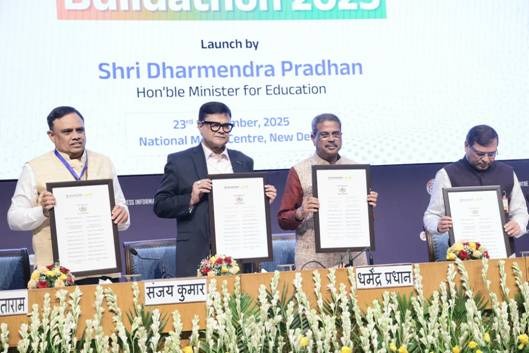
Syllabus: GS Paper III – Science & Technology / Education: Innovation, Skill Development, and Student Engagement
Context: Launched by Union Education Minister Dharmendra Pradhan, the Viksit Bharat Buildathon 2025 engages school students across India in a nationwide innovation hackathon, promoting creativity, problem-solving, and contributions to India’s development.
Key Points
- Objective: Encourage students to develop innovative solutions supporting national growth and self-reliance.
- Themes: Focus on Vocal for Local, Atmanirbhar Bharat, Swadeshi, and Samriddhi.
- Organisers: Led by Department of School Education & Literacy, in partnership with Atal Innovation Mission, NITI Aayog, and AICTE.
- Educational Partners: Active involvement of KVS, NVS, and senior officials to ensure quality and reach.
- Event Timeline:
- 23 Sept – 6 Oct 2025: Student registration
- 6 – 13 Oct: Preparation phase guided by teachers
- 13 Oct: Live Synchronized Innovation Event
- Up to 31 Oct: Submission of final prototypes
- Nov – Dec: Evaluation by expert panels
- Jan 2026: Announcement of winners
- Recognition: Over 1,000 top innovators will be recognised nationally.
- Significance for Education: Builds on initiatives like School Innovation Marathon 2024, promoting creative thinking, problem-solving, and entrepreneurship.
- National Impact: Cultivates future innovators, strengthens innovation culture in schools, and aligns student projects with national development priorities.
Source: Indian Express
11. Mahendragiri Hills
Syllabus: GS Paper III – Environment and Ecology: Biodiversity, Conservation, and Environmental Challenges
Context: Environmentalists have expressed concern over unchecked tourism and construction in the ecologically fragile Mahendragiri Hills of Odisha, despite its Biodiversity Heritage Site status since 2022, threatening local flora and fauna.
Key Points
- Mountain Range: Part of the Eastern Ghats, with mythological, cultural, and ecological significance.
- Biodiversity Heritage Site: Declared in 2022 for its rich flora and fauna.
- Location: Gajapati district, Odisha, elevation 1,501 meters, about 175 km from Berhampur.
- Flora & Fauna: Hosts 1,348 plant species and 388 animal species, many endemic and threatened.
- Cultural Significance: Known as Mahendra Parvata in Ramayana and Mahabharata; associated with Lord Parashurama’s penance.
- Temples: Includes Panchpandava temples and Shiva shrines, attracting pilgrims during Maha Shivaratri.
- Tribal Communities: Inhabited by Saora (Saura) and Kondh tribes, dependent on forests for livelihoods.
- Ecological Fragility: Mountain ecosystem is stressed by deforestation, tourism pressure, and declining wildlife (e.g., elephants, tigers).
Source: Down to Earth (DTE)
12. India Elected as Member of Interpol Asian Committee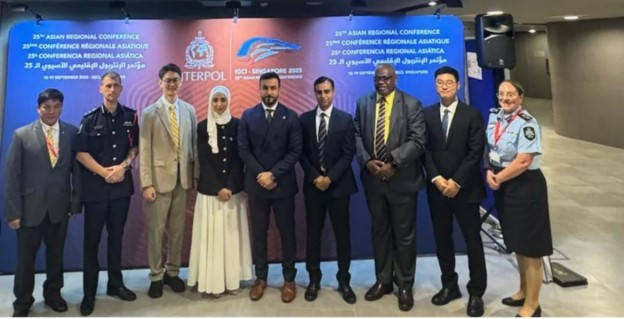
Syllabus: GS Paper II – International Relations / Internal Security: International Policing and Regional Security Cooperation
Context: India was elected to the Interpol Asian Committee during the 25th Asian Regional Conference in Singapore, marking a step forward in enhancing regional cooperation on security challenges. The Central Bureau of Investigation (CBI) represented India in the process.
Key Points
- Committee Role: Advises the Asian Regional Conference, guiding coordinated actions among member countries.
- Annual Meetings: The committee meets once a year to discuss strategic and operational security issues.
- Focus Areas: Tackles organised crime, cybercrime, human trafficking, terrorism, and drug trafficking.
- Regional Priorities: Identifies Asia-specific security challenges and promotes police cooperation.
- India’s Representation: Led by the CBI, India contributes expertise and operational experience in international policing.
- Significance: Reflects India’s growing leadership in law enforcement and commitment to transnational security goals.
- Impact: Strengthens collaboration among Asia-Pacific countries for effective cross-border crime prevention.
Source: Indian Express
13. Tamil Nadu Coastal Restoration Mission (TN-SHORE)
Syllabus: GS Paper III – Environment and Ecology / Disaster Management: Coastal Ecosystems, Biodiversity, and Climate Resilience 
Context: Launched in 2025 with World Bank funding, TN-SHORE aims to enhance coastal resilience in Tamil Nadu through mangrove restoration, biodiversity protection, and development of a sustainable coastal economy. Key Points
- Project Size & Funding: Total cost ₹1,675 crore; World Bank contributes ₹1,000 crore, rest by Tamil Nadu government.
- Objective: Restore 30,000 hectares of seascapes, support endangered species like turtles and dugongs, and strengthen coastal ecosystems.
- Focus Areas:
- Mangrove plantation
- Plastic waste management
- Eco-tourism promotion
- Community Participation: Village mangrove councils manage funds directly, consisting of local residents led by a community president and forest officials as secretaries.
- Fund Management: Councils can utilise allocations up to ₹8 lakh without tenders, enabling faster and simpler procurement.
- Restoration Targets: Councils restore 1,000 hectares of mangroves, including 300 hectares of new plantations and 700 hectares of degraded areas.
- Impact: Combines ecosystem restoration with eco-friendly livelihoods, enhancing coastal resilience and community empowerment.
Source: Down to Earth (DTE)











